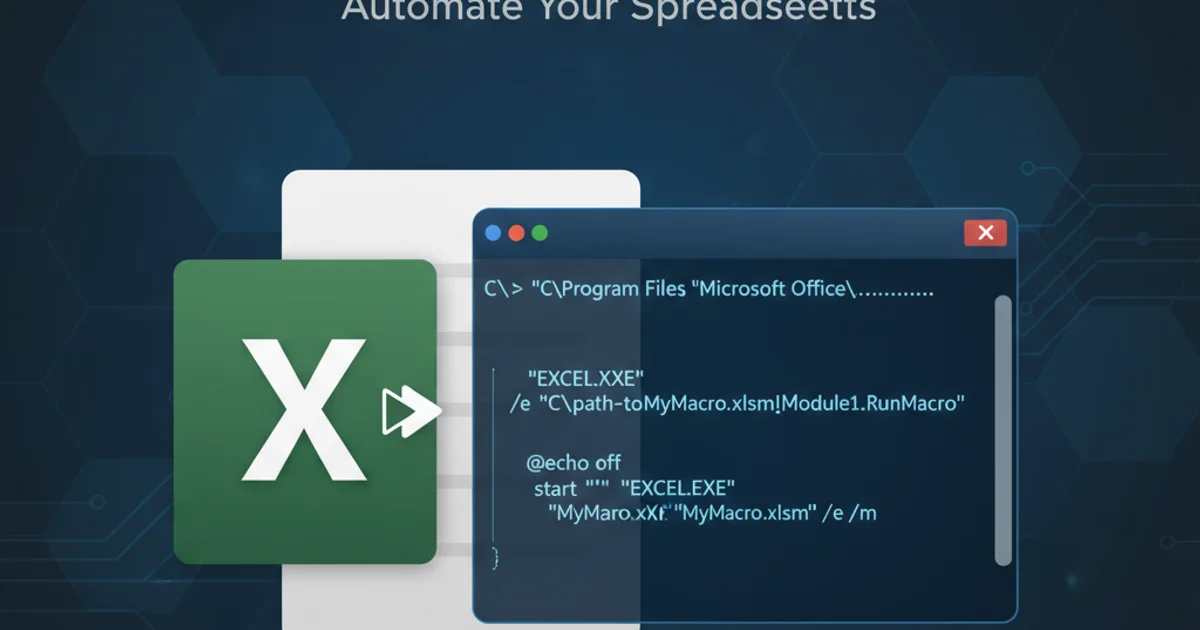Way to run Excel macros from command line or batch file?
Categories:
Automating Excel: Running Macros from the Command Line or Batch Files

Discover how to execute Excel macros programmatically using command-line arguments and batch files, enabling powerful automation for data processing and reporting tasks.
Microsoft Excel macros, written in VBA (Visual Basic for Applications), are incredibly powerful for automating repetitive tasks within spreadsheets. However, manually opening Excel and triggering a macro can still be a bottleneck in larger automation workflows. This article explores various methods to run Excel macros directly from the command line or a batch file, allowing you to integrate Excel automation into scheduled tasks, scripts, or other applications. We'll cover techniques ranging from simple command-line calls to more robust VBScript solutions.
The Challenge of Direct Execution
Excel (and its VBA environment) isn't designed for direct command-line execution of macros in the same way a standalone script might be. There's no built-in command-line switch like /runmacro:MyMacro that you can pass to excel.exe. This means we need to use intermediary scripting languages, primarily VBScript, to bridge the gap between the command line and Excel's object model.
flowchart TD
A[Command Line/Batch File] --> B{VBScript Interpreter}
B --> C["Create Excel.Application Object"]
C --> D["Open Workbook (e.g., 'MyWorkbook.xlsm')"]
D --> E["Run Macro (e.g., 'MyMacro')"]
E --> F["Save/Close Workbook"]
F --> G["Quit Excel Application"]
G --> H[Automation Complete]Workflow for running an Excel macro from the command line using VBScript.
Method 1: Using VBScript to Control Excel
The most common and flexible approach involves creating a VBScript (.vbs) file. This script will instantiate an Excel application object, open your workbook, run the specified macro, and then optionally save and close the workbook before quitting Excel. This method provides full control over the Excel application lifecycle.
Set objExcel = CreateObject("Excel.Application")
objExcel.Visible = False ' Set to True for debugging
Set objWorkbook = objExcel.Workbooks.Open("C:\Path\To\Your\Workbook.xlsm")
' Run the macro
objExcel.Application.Run "MyWorkbook.xlsm!Module1.MyMacro"
' Optional: Save and close
' objWorkbook.Save
' objWorkbook.Close
objExcel.Quit
Set objWorkbook = Nothing
Set objExcel = Nothing
WScript.Echo "Macro execution complete."
Module1) and not within a worksheet or ThisWorkbook module, unless you explicitly qualify its path (e.g., ThisWorkbook.MyMacro). Also, make sure the workbook path is correct and accessible.Method 2: Calling the VBScript from a Batch File
Once you have your VBScript file, you can easily execute it from a batch file (.bat) or directly from the command prompt using the cscript or wscript command. cscript runs the script in a command-line interface, while wscript uses a Windows-based host, often displaying message boxes. For automation, cscript is generally preferred as it's less intrusive.
@echo off
SET VBS_SCRIPT="C:\Path\To\Your\run_excel_macro.vbs"
cscript //NoLogo %VBS_SCRIPT%
IF %ERRORLEVEL% NEQ 0 (
ECHO An error occurred during VBScript execution.
) ELSE (
ECHO Excel macro executed successfully.
)
pause
Passing Arguments to Macros
For more dynamic automation, you might need to pass parameters from your batch file or command line to your Excel macro. This can be achieved by extending the VBScript to accept command-line arguments and then passing those arguments to the VBA macro.
Set objExcel = CreateObject("Excel.Application")
objExcel.Visible = False
Set objWorkbook = objExcel.Workbooks.Open("C:\Path\To\Your\Workbook.xlsm")
' Get command-line arguments
Set objArgs = WScript.Arguments
If objArgs.Count > 0 Then
param1 = objArgs(0)
' You can add more parameters as needed
' param2 = objArgs(1)
Else
param1 = "DefaultValue"
End If
' Run the macro with arguments
' The VBA macro 'MyMacroWithArgs' should accept parameters
' Example VBA: Sub MyMacroWithArgs(arg1 As String)
objExcel.Application.Run "MyWorkbook.xlsm!Module1.MyMacroWithArgs", param1
objWorkbook.Save
objWorkbook.Close
objExcel.Quit
Set objWorkbook = Nothing
Set objExcel = Nothing
Set objArgs = Nothing
WScript.Echo "Macro with arguments executed."
@echo off
SET VBS_SCRIPT="C:\Path\To\Your\run_macro_with_args.vbs"
SET MACRO_ARG="Hello from Batch!"
cscript //NoLogo %VBS_SCRIPT% %MACRO_ARG%
IF %ERRORLEVEL% NEQ 0 (
ECHO An error occurred.
) ELSE (
ECHO Macro with argument executed successfully.
)
pause
Sub MyMacroWithArgs(ByVal myStringParam As String, Optional ByVal myIntParam As Long = 0).Alternative: Using PowerShell
While VBScript is a classic choice, PowerShell offers a more modern and powerful scripting environment for Windows. It can also interact with the Excel COM object model, providing similar functionality to VBScript but with more robust error handling and scripting capabilities.
$excel = New-Object -ComObject Excel.Application
$excel.Visible = $false # Set to $true for debugging
$workbookPath = "C:\Path\To\Your\Workbook.xlsm"
$workbook = $excel.Workbooks.Open($workbookPath)
$macroName = "MyWorkbook.xlsm!Module1.MyMacro"
# Example of passing arguments (if your macro accepts them)
# $arg1 = "Value1"
# $excel.Run($macroName, $arg1)
$excel.Run($macroName)
$workbook.Save()
$workbook.Close()
$excel.Quit()
# Clean up COM objects
[System.Runtime.InteropServices.Marshal]::ReleaseComObject($workbook)
[System.Runtime.InteropServices.Marshal]::ReleaseComObject($excel)
Remove-Variable excel, workbook
Write-Host "Excel macro executed via PowerShell."
1. Prepare your Excel Workbook
Ensure your Excel workbook (.xlsm or .xlsb) contains the macro you wish to run. Place the macro in a standard module (e.g., Module1) and make sure it's functional when run manually.
2. Create the VBScript File
Write the VBScript code (e.g., run_excel_macro.vbs) that will open Excel, execute your macro, and then close Excel. Adjust the workbook path and macro name accordingly.
3. Create the Batch File
Develop a batch file (e.g., execute_macro.bat) that calls your VBScript using cscript //NoLogo. This allows for easy execution from the command line or a scheduler.
4. Test Execution
Open a command prompt, navigate to the directory containing your batch file, and run it. Observe the output and verify that the Excel macro performed its intended actions.
5. Schedule the Task (Optional)
Use Windows Task Scheduler to automate the execution of your batch file at specific times or in response to certain events, fully integrating your Excel automation into your workflow.